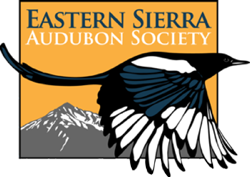Mono Lake Basin Important Bird Area
Text and photos from National Audubon Society IBA Database Site Profile
Mono Lake Basin Site Description
Internationally famous Mono Lake lies on the boundary between the Great Basin and the Sierra Nevada, which rises 6,000 feet above the lake's surface to the west. Hundreds of thousands of years of evaporation have concentrated salts and other minerals within the lake, making it 2 to 3 times as salty as the ocean. Algae in its water supports brine shrimp in the trillions as well as alkali flies that carpet the shore. This simple ecosystem feeds millions of migratory birds each year, which also utilize the marsh and alkali meadows that ring the lake. Upslope, the basin is dominated by sagebrush steppe, with pinyon-juniper forests on the higher elevations. To the south lies a vast Jeffrey pine forest, with mountain mahogany (Cercocarpus) on the sun-baked ridges. The lake's tributary streams, in the process of being restored, will support cottonwood-willow riparian forests with dense understory and wet meadows. Also dotting the Mono Basin are irrigated pasture and a few freshwater ponds created to provide waterfowl habitat. The Mono Basin is one of the most intensively studied natural areas in California, beginning with the pioneering birding and conservation work of David Gaines and David Winkler in the 1970s, and continuing to the present with biologists from PRBO. Litigation resulted in the California Supreme Court's 1983 Public Trust decision, which reaffirmed the state's duty to balance the public trust with water allocations and thereby protect the common natural heritage of Californians. In 1994, the State Water Resources Control Board amended the licenses for water diversion of the Los Angeles Dept. of Water and Power, setting a minimum level for the lake high above the then-current level, thereby saving Mono Lake. Most of the land in the Mono Basin is managed by the USFS, the State of California or the BLM, with many other California resources agencies involved in protecting this unique ecosystem. Updated by Eastern Sierra Audubon, October 2008.

Mono Lake Basin Important Bird Area © Photo by Andrea Jones
Conservation Issues
The 1994 decision by the State Water Board set a target elevation for the water level of Mono Lake by establishing required minimum and peak stream flows into the lake, and called for specific restoration activities. Still, water continues to be diverted (with associated alteration of flows), which inhibits the full development of riparian and wetland habitat. Though banned from most riparian areas, grazing continues to degrade meadows and riparian systems in the basin (fide S. Heath, PRBO). Increased recreation at the lake has the potential to impact birds that are resting and feeding, particularly during migration, and development proposals, if implemented, would impact sagebrush and meadow habitat within the basin (L. Cutting, in litt.).
Ornithological Summary
Islands within Mono Lake support 50% of California's nesting population of California Gull (20,000+ pr) Mono Lake remains the second-largest rookery in the world after Utah's Great Salt Lake (Shuford and Ryan 2000), but it may soon be surpassed by the South SF Bay's total nesting population. These gulls are joined by Caspian Tern and Snowy Plover, the latter maintaining one of its largest California breeding areas (Page et al. 1981). In summer, over a hundred thousand phalaropes (Wilson's and Red-necked) descend upon Mono Lake, where they complete their molt before continuing on to wintering grounds in South America. Mono Lake is one of the key interior shorebird sites in the state. Over 20,000 Least and Western sandpipers have been recorded on single-day surveys in spring and fall counts of American Avocet have exceeded 10,000 (Shuford et al.). After the fall passage of shorebirds, the migration of Eared Grebe through eastern California surges, with up to two million birds recorded on the lake in recent years (the primary fall staging site in the world). Many of these grebes winter at the Salton Sea and Gulf of California. Willow Flycatchers, extremely local in the Sierra Nevada and eastern California, have been discovered breeding in the streams on the west side of the basin along Rush Ck. (S. Heath, PRBO, pers. comm.), and Virginia's Warbler, even more localized in California, maintains small breeding groups on ridges (M. Green, pers. comm.). From research conducted by PRBO, the creeks within the basin support the highest indices of breeding songbird diversity and species richness of 33 creeks surveyed in the eastern Sierra Nevada (Ibid). The basin lies between two major populations of Greater Sage-Grouse (Bodie Hills and Long Valley), and small numbers have been observed in lush stands of sagebrush (most recently discovered breeding along Walker Creek, fide T. Floyd). Yellow Rail historically bred in the wet meadows of Mono County (Grinnell and Miller 1944).
Help us learn more about the birds at this IBA! Enter your birding data online at California eBird! (http://ebird.org/california/)
Click here for a bar chart of eBird observations in the Mono Lake Basin
For great birding at Mono Lake and Mono Highlands, also check with the Mono Lake Committee, which often offers field trips in the area. Also, the Mono Basin Bird Chautauqua is an awesome annual event to enjoy and learn about the birds in this area.


